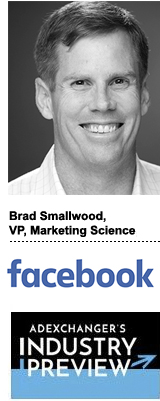
Brad Smallwood, VP of marketing science at Facebook, will take the stage Jan. 19 to talk all things measurement at Industry Preview in New York City.
Facebook is at a crossroads in the way it relates to the media, thinks about monetization and measures ads.
Right before Advertising Week, Facebook admitted to what became a string of ad metric errors that triggered calls for more transparency and third-party measurement from agency and advertiser partners.
The “metrics situation” was a learning opportunity, said Brad Smallwood, VP of marketing science at Facebook, where he leads a team tasked with client and campaign measurement, product development, partnerships and advertising research.
“The takeaway for us is to focus on the concept of transparency,” Smallwood said. “That’s a big part of why we have the Measurement Council, which is like a sounding board to help us understand what people really care about.”
Facebook formed the council in November to help its internal measurement teams liaise with advertisers and agencies on product development and standards.
Increased third-party verification is also on the table, building on existing relationships with Moat, Nielsen, Integral Ad Science and Moat.
AdExchanger spoke with Smallwood.
AdExchanger: What’s the main takeaway from Facebook’s measurement issues?
BRAD SMALLWOOD: First, there is a difference between metrics and measurement, a distinction. The challenges of a few months ago on the metrics side were around the fact that one of many metrics was calculated one way when, quite honestly, it should have been calculated a different way. We see that as a metric issue, not as a measurement issue.
But what we take away is this: Advertisers want control, and they want complete understanding and transparency when it comes to how data is passed and how metrics are calculated. We’re passing more and more information to our viewability vendor partners so that advertisers can calculate metrics any way they want. We give them the raw data so they don’t have to completely rely on us for metrics.
Facebook shut down the ad server part of Atlas in November, but kept the measurement piece. What does that mean from a practical perspective?
Advertisers want choice in the measurement systems they use, and Atlas is one of those choices. If advertisers want to use Atlas, that’s great, and if they want to use Nielsen, for example, that’s OK, too.
The reason we brought Atlas together [with the marketing science team] is because we recognize that advertisers don’t want to push measurement through one particular tool or system.
Will Facebook be more transparent this year and what does that mean for measurement?
I wouldn’t say “this year.” We’re not starting this year and we’re not ending this year. Our focus is on independent third-party measurement and helping advertisers measure in the ways they want to. That’s been pretty consistent.
But where transparency is accelerating is that we’re now letting people calculate whatever number they want to calculate. The shift is in providing more raw data to our advertisers.
What measurement tools are advertisers asking for, and what’s on the road map?
We’re hearing a lot about viewability, knowing that an impression actually entered the viewable area, as well as more and more information about that impression – things like duration and how much of the ad appears on the screen. In other words, a basic understanding of what exactly happened as a person looks at the marketing message.
But while that’s all well and good, what marketers really care about is whether their message is driving behavioral change, and there are two pieces to that. One is understanding whether there was a behavioral change that happened, and the second is whether that change was driven by the marketing. What incremental lift or sales happened as a result?
We’re building tools to help marketers with that, not just at the campaign level, but at a granular enough level that they can make changes to their marketing plan.
Much of what we’re hearing from advertisers is around the need for a measurement system that shows what’s working and what’s not, beyond ROI. And that’s because with digital we have the ability to use that information to directly impact planning and buying and to improve efficiencies, as opposed to television, where you just have to wait for the next upfront to come around.
This post was syndicated from Ad Exchanger.

More Stories
The Tuesday Club hosts Women’s Work’s In(visible) exhibition in Tāmaki Makaurau
Under Armour Taps Estée Lauder Exec to Lead AI and Analytics
Lani Jamieson joins D3 to shape the next chapter of its growth